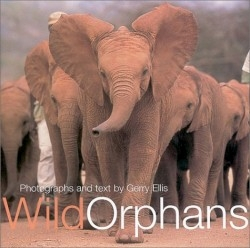Wild Orphans
Recent research shows that elephants and humans have many things in common, and readers of this book will see clearly how much the two species are alike.
The author, a gifted wildlife photographer, followed a group of orphaned baby elephants from their rescues, through their arrival at David Sheldrick Wildlife Trust’s Orphanage outside Nairobi in Kenya, and then to their eventual release into Tsavos National Park. The Wild Orphans project (originally intended to follow wild orphans of several species) took four years and spawned its own organization, Globio, to “put a face on the environmental issues I had been documenting,” according to Ellis.
He has done a masterful job. Photos at once amusing and poignant depict baby elephants in all stages of rescue and babyhood, as they learn to drink from bottles, nuzzle their human keepers, forage, and play in mudbaths. The book’s layout is superb, pairing photos of babies in the wild and babies in the orphanage doing the same things; the shot of a human keeper shading his little charge under a brightly colored golf umbrella contrasts starkly with a wild baby sheltering under the bulk of an adult elephant within the herd. What these wild orphans have lost is as obvious as the gentle determination of their keepers to see these babies survive. “No other animals on Earth build their lives so tightly around their immediate and extended family members than elephants do-not even humans,” says the author.
Ellis’s text, too, is moving; he relates the babies’ stories in ways that touch the heart. “Elephants are self-aware,” he quotes researcher Joyce Poole, and goes on: “Regardless of how an elephant dies-by poaching, slaughter, culling, endangerment, or falling down a well-its death inflicts serious psychological damage on other elephants. Considering elephants’ ability to communicate over long distances, the tentacles of pain and agony may stretch farther than we know.”
Photos showing a baby elephant peering out shyly from behind the legs of head keeper Mishak Nzimbi or mouthing the shaved head of keeper Julius Latoya remind readers that these are babies. The series of photographs at the mud bath, when one baby has a panic attack and the larger elephants step in immediately to soothe and assist him, drives home the fact that these animals are very aware indeed.
This is a book to be read by adults and by children, preferably together, so that both can share in the magic of caring that goes on between the babies and their keepers, and the babies and the older adults they encounter as they grow. Perhaps it will also serve as an introduction to what people must do to preserve their fellow creatures on the Earth.
Reviewed by
Marlene Satter
Disclosure: This article is not an endorsement, but a review. The publisher of this book provided free copies of the book to have their book reviewed by a professional reviewer. No fee was paid by the publisher for this review. Foreword Reviews only recommends books that we love. Foreword Magazine, Inc. is disclosing this in accordance with the Federal Trade Commission’s 16 CFR, Part 255.

